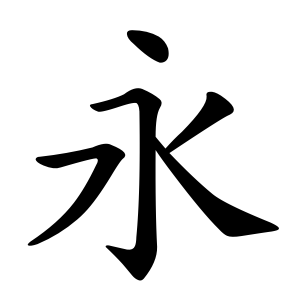永
- long, eternal, everlasting;
Used to denote unending time, continuity, or perpetuity.
Etymology
Pictograph depicts a person moving through water, arms and legs extended.
Originally meant “to swim.”
Later borrowed to mean “long, enduring,” while the original “swim” meaning was preserved separately by adding the water radical to create 泳 (“to swim”).
Semantic range:
- long, enduring (시간이 길다)
- eternal, perpetual (영원 永遠)
- figurative: constancy, lasting qualities
Usage in Korean
영원 (永遠) – eternity, forever
영구 (永久) – permanent, lasting
영생 (永生) – eternal life
영속 (永續) – perpetuity, continuation
영대 (永代) – for generations, perpetual
Words that derived from 永
Additional notes
Historically used in personal names, especially for boys, as a wish for long life in times of short average lifespan (e.g., 영수, 영호, 영철, 영준).
Still common in Korean names without a “dated” or old-fashioned feel.
One of the most frequently used characters in Japanese era names (年号, 연호), including 嘉永 (Ka’ei, 1848–1854).
- 戈弓水 (INE)
- ⿱丶⿲㇇𠃌⿺㇏丿)
